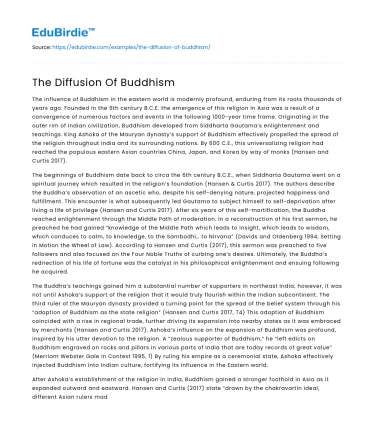The influence of Buddhism in the eastern world is modernly profound, enduring from its roots thousands of years ago. Founded in the 6th century B.C.E. the emergence of this religion in Asia was a result of a convergence of numerous factors and events in the following 1000-year time frame. Originating in the outer rim of Indian civilization, Buddhism developed from Siddharta Gautama’s enlightenment and teachings. King Ashoka of the Mauryan dynasty’s support of Buddhism effectively propelled the spread of the religion throughout India and its surrounding nations. By 600 C.E., this universalizing religion had reached the populous eastern Asian countries China, Japan, and Korea by way of monks (Hansen and Curtis 2017).
The beginnings of Buddhism date back to circa the 6th century B.C.E., when Siddharta Gautama went on a spiritual journey which resulted in the religion’s foundation (Hansen & Curtis 2017). The authors describe the Buddha’s observation of an ascetic who, despite his self-denying nature, projected happiness and fulfillment. This encounter is what subsequently led Gautama to subject himself to self-deprivation after living a life of privilege (Hansen and Curtis 2017). After six years of this self-mortification, the Buddha reached enlightenment through the Middle Path of moderation. In a reconstruction of his first sermon, he preached he had gained “knowledge of the Middle Path which leads to insight, which leads to wisdom, which conduces to calm, to knowledge, to the Sambodhi… to Nirvana” (Davids and Oldenberg 1994, Setting in Motion the Wheel of Law). According to Hansen and Curtis (2017), this sermon was preached to five followers and also focused on the Four Noble Truths of curbing one’s desires. Ultimately, the Buddha’s redirection of his life of fortune was the catalyst in his philosophical enlightenment and ensuing following he acquired.
Save your time!
We can take care of your essay
- Proper editing and formatting
- Free revision, title page, and bibliography
- Flexible prices and money-back guarantee
The Buddha’s teachings gained him a substantial number of supporters in northeast India; however, it was not until Ashoka’s support of the religion that it would truly flourish within the Indian subcontinent. The third ruler of the Mauryan dynasty provided a turning point for the spread of the belief system through his “adoption of Buddhism as the state religion” (Hansen and Curtis 2017, 74) This adoption of Buddhism coincided with a rise in regional trade, further driving its expansion into nearby states as it was embraced by merchants (Hansen and Curtis 2017). Ashoka’s influence on the expansion of Buddhism was profound, inspired by his utter devotion to the religion. A “zealous supporter of Buddhism,” he “left edicts on Buddhism engraved on rocks and pillars in various parts of India that are today records of great value” (Merriam Webster Gale in Context 1995, 1) By ruling his empire as a ceremonial state, Ashoka effectively injected Buddhism into Indian culture, fortifying its influence in the Eastern world.
After Ashoka’s establishment of the religion in India, Buddhism gained a stronger foothold in Asia as it expanded outward and eastward. Hansen and Curtis (2017) state “drawn by the chakravartin ideal, different Asian rulers made a series of individual decisions to support Buddhism” (241). This series of decisions began circa 120 C.E., when the leader Kanishka of north India “launched a missionary movement to introduce… Buddhism to Central Asia and China” (Hansen and Curtis 2017, 241). Monks and other proponents of Buddhism were the carriers that allowed the religion to spread through relocation diffusion. A few centuries later, Chinese, Korean, and Japanese rulers converted to Buddhism, their kingdoms ensuing (Hansen and Curtis 2017). By 600 C.E., Buddhism had become well established in multiple regions of Asia and had developed into a major world religion.
From what had begun in the outskirts of civilization in northern India, Buddhism gained a massive amount of influence to become a universalizing religion by the close of the 6th century C.E. It found its origin in Siddharta Gautama a thousand years earlier after his worldly observations inspired him to embark on a spiritual journey. From this starting point, it first spread through India because of the actions of Ashoka, later reaching much of the continent through other leaders and the respective missionary work they supported. These factors ultimately played a major role in the diffusion of Buddhism and allowed it to establish itself in the eastern hemisphere.






 Stuck on your essay?
Stuck on your essay?

